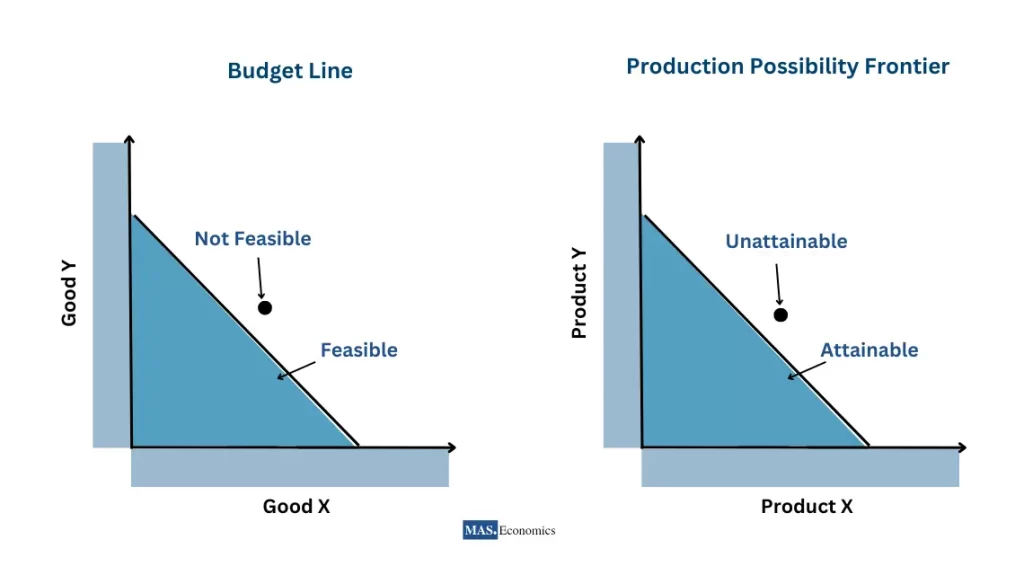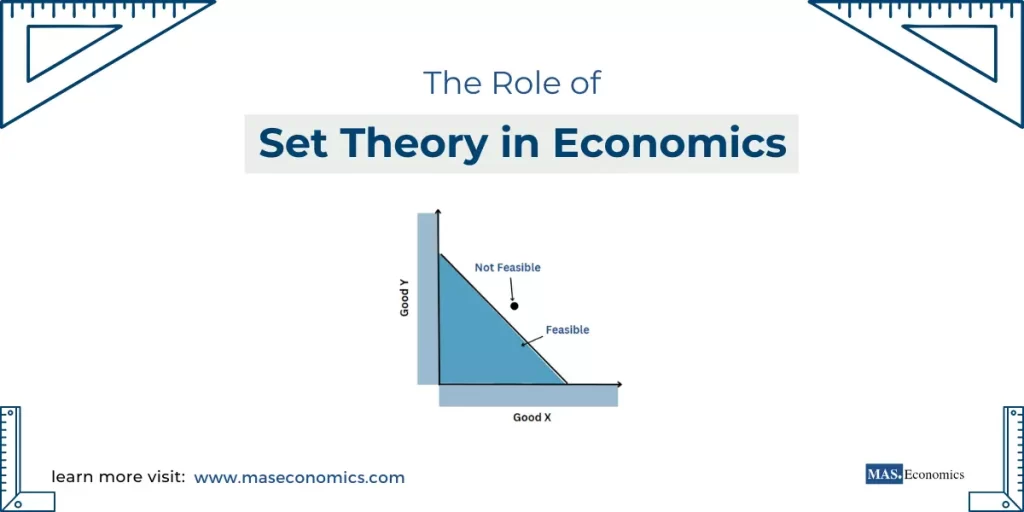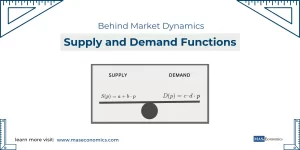Set theory might seem like an abstract branch of mathematics, but it plays a vital role in economics. It provides the foundation for defining feasible regions for consumption, production, and investment. Economists use set theory to determine what is possible, what is optimal, and what is unattainable given various constraints such as income, resources, or market conditions. By understanding sets, economists can clearly illustrate how different choices are available to consumers and firms and identify the boundaries within which they operate.
What is Set Theory?
Set theory is a branch of mathematics that studies sets, which are collections of distinct objects or elements. In economics, these elements could be prices, quantities, resources, or other economic variables. Sets are used to describe various relationships and the range of possible choices available.
Set Notation: Sets are typically represented using curly braces. For example, a set of goods available in a market might be represented as:
In which \( S \) is a set consisting of goods \( a, b, c, \) and \( d \).
Subset: A subset is a part of a larger set. If \( A \) is a subset of \( S \), it means that all elements of \( A \) are also elements of \( S \). In economics, subsets can represent feasible consumption bundles given budget limitations.
Set Theory in Economics
Budget Constraints and Consumer Choice
One of the most intuitive uses of set theory in economics is in understanding budget constraints. The budget set represents all the combinations of goods that a consumer can afford, given their income and the prices of goods. We can express the budget set as:
In which:
- \(x_1, x_2\): Quantities of two goods.
- \(p_1, p_2\): Prices of the goods.
- \(M\): Consumer’s income.
This set \(B\) defines all the bundles that are feasible under the consumer’s budget. It helps visualize the trade-offs a consumer must make when deciding how to allocate their income between different goods. For example, if a consumer has a budget of $100, and the prices of goods \(x_1\) and \(x_2\) are $20 and $10 respectively, the budget set defines all possible combinations of the two goods they can afford without exceeding $100.
Set theory also helps in determining what is not feasible—any combination of goods outside of the budget set would require more income than is available. By clearly defining feasible and infeasible choices, set theory provides a framework for understanding consumer preferences, demand, and trade-offs.
Production Possibility Set
Another fundamental application of set theory in economics is in defining Production Possibility Sets (PPS). The PPS represents all the possible combinations of goods or services that an economy can produce, given its resources and technology. It is often visualized through the Production Possibility Frontier (PPF), which shows the maximum attainable output combinations.
For instance, consider an economy that produces two goods: wheat and machinery. The production possibility set can be represented as:
In which:
- \(y_1, y_2\): Quantities of wheat and machinery.
- \(f(y_1, y_2)\): A production function that represents the relationship between the inputs used and outputs produced.
- \(R\): Available resources.
The production possibility set \(P\) includes all feasible production choices. The PPF is the boundary of this set, showing the combinations that utilize all resources fully and efficiently. Any point inside the PPF represents underutilization of resources, while points outside the PPF are unattainable with the given resources.
Investment Opportunities and Feasibility Sets
In the world of investment, set theory is used to determine the feasibility set for an investor. The feasibility set includes all possible portfolios that an investor can create, given their budget and the available assets. Suppose an investor has $10,000 and can invest in three different assets. We could define the set of feasible portfolios as:
In which \(a_1, a_2, a_3\) are the amounts allocated to each asset. This feasibility set helps investors understand the trade-offs they face in allocating their limited budget across different assets, thereby aiding in constructing efficient portfolios that align with their risk-return preferences.
Set Operations and Their Use in Economics
In addition to defining feasible sets, set theory includes various operations—such as union, intersection, and complement—that can be applied to analyze economic problems.
Union and Intersection
The union of two sets includes all elements that are in either set, while the intersection includes only those elements common to both sets. In economic contexts, unions and intersections can be used to analyze market opportunities.
For example, consider two markets with different sets of consumers, \(A\) and \(B\). The union of these sets, \(A \cup B\), represents all potential consumers from both markets. The intersection, \(A \cap B\), represents consumers who are common to both markets—perhaps those who have overlapping preferences.
Complement
The complement of a set includes all elements not in the set. In economics, this is often used to define infeasible choices or outcomes that lie outside of the feasible region. For instance, the complement of the budget set represents all combinations of goods that a consumer cannot afford, given their income and prices.
Visualizing Feasibility with Set Theory
A key benefit of using set theory in economics is the ability to visualize feasible and infeasible regions. Graphical representations make abstract economic concepts more intuitive. Consider a simple budget constraint graph, where the axes represent quantities of two goods. The area under the budget line represents the feasibility set—all the consumption bundles that the consumer can afford.
Similarly, the production possibility frontier is a graphical representation of the production possibility set, showing feasible production combinations. These visual tools are invaluable for illustrating concepts like opportunity cost, efficiency, and trade-offs, all of which are central to economic theory.

Right Diagram: Production Possibility Frontier: Attainable vs. Unattainable Production Combinations.
Applications Beyond the Basics
Set theory extends beyond simple feasibility analysis and plays a role in more advanced economic fields like game theory. In game theory, strategies available to players can be represented as sets, with each player’s strategy set defining the choices they can make. The concept of Nash Equilibrium—a situation where no player can benefit from changing their strategy while others keep theirs unchanged—can be defined as the intersection of best-response sets.
In market analysis, firms often define target consumer segments as sets. For instance, if a company wants to target both tech-savvy consumers and high-income households, set theory can be used to define and visualize the overlap between these groups, helping the firm optimize its marketing strategy.
Conclusion
Set theory provides a powerful framework for understanding economic feasibility and choices. By defining feasible sets for consumption, production, and investment, set theory helps economists and decision-makers understand the limits of what is possible and make informed decisions within those constraints. Whether it’s a consumer deciding how to allocate their budget, a firm choosing its production strategy, or an investor selecting an optimal portfolio, set theory helps simplify complex decisions by clearly delineating feasible and infeasible choices.
FAQs:
What is the role of set theory in economics?
Set theory provides a framework for defining and analyzing feasible choices, constraints, and outcomes in economics. It helps economists identify which options are possible given budget limitations, production capacities, or available resources. This clarity supports better decision-making for consumers, firms, and policymakers.
How does set theory apply to budget constraints and consumer choice?
In economics, the budget set defines all the combinations of goods a consumer can afford given their income and the prices of those goods. Set theory helps visualize feasible consumption bundles and illustrates trade-offs when choosing between different goods. Any choice outside the budget set is considered infeasible, requiring more income than available.
What is the Production Possibility Set, and how does set theory relate to it?
The Production Possibility Set (PPS) represents all possible combinations of goods or services an economy can produce with its given resources and technology. The Production Possibility Frontier (PPF) is the boundary of the PPS, indicating efficient production levels. Set theory helps define feasible production points inside the PPS and identify unattainable points beyond it.
How does set theory help in investment decisions?
Set theory is used to define the feasibility set for investors, representing all possible portfolios given a budget and available assets. This feasibility set illustrates the trade-offs investors face when allocating funds across different assets, aiding in portfolio optimization according to risk-return preferences.
What are the union, intersection, and complement of sets, and how are they used in economics?
- Union: The union of two sets includes all elements that belong to either set, useful in combining consumer groups or market opportunities.
- Intersection: The intersection contains only elements common to both sets, helping identify overlapping market segments or shared consumer preferences.
- Complement: The complement of a set represents elements not included in that set. In economics, it defines infeasible choices, such as goods beyond a consumer’s budget.
How does set theory aid in visualizing economic choices?
Set theory allows economists to use graphs, such as budget constraint graphs and production possibility frontiers, to represent feasible and infeasible regions. These visual tools make it easier to understand trade-offs, opportunity costs, and efficiency, providing deeper insights into economic behavior.
What advanced economic fields use set theory?
Set theory plays a crucial role in game theory and market analysis. In game theory, strategy sets define the possible actions players can take, with the Nash equilibrium being the intersection of players’ best-response sets. In market analysis, firms use set theory to identify and target overlapping consumer segments, improving marketing strategies.
Why is set theory essential for economic analysis and decision-making?
Set theory simplifies complex decisions by clearly delineating feasible and infeasible options, helping individuals and organizations make informed choices. It supports a variety of applications, from consumer behavior analysis to investment strategy and production planning, making it an invaluable tool in both theoretical and practical economics.
Thanks for reading! Share this with friends and spread the knowledge if you found it helpful.
Happy learning with MASEconomics




